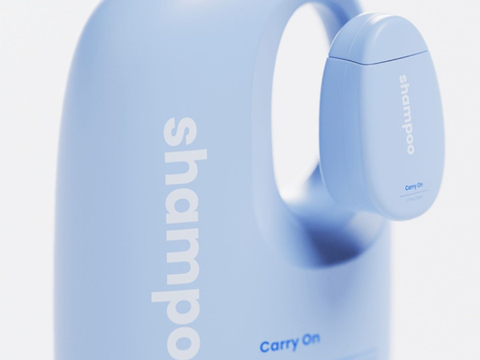
Hongik University student and industrial designer Seokoo Yeo has developed Carry On, a solution expected to help consumers remember their travel-sized cosmetics and prevent both packaging and product waste.
Carry On constitutes a larger container with space to hold a smaller, travel-sized version of the same pack. It intends to remind consumers of the smaller pack’s existence and ensure the product is used.
“Mini-sized toiletries are often forgotten and after a long time, it is thrown away with some remainings (sic) in it,” said Seokoo Yeo in an Instagram post. “I believe that these kinds of meaningless wastes could be changed with some simple changes in design.
“The main concept is combining [a] mini container with the normal container that we use daily. Through this small change, I aim to make mini ones more recognizable and eventually reduce [the] meaningless wastes of the mini ones. Users can carry on their sustainable journey by reducing the wastes.”
The mini container can be removed from the larger pack to be used. Its round surface and small pit are thought to ensure that the removal process is smooth, and that it remains stable when re-inserted.
The empty space in the large container is set to signal to consumers that a travel pack is missing, serving as another reminder to use the product. It can also be used as a handle with which to hold the larger pack.
As well as their outer boxes, Carry On containers containing shampoo and conditioner each come in a shade of blue, while the body wash is pink. The differentiation aims to prevent consumers from confusing the products.
The label on the back of the product also claims to provide “basic description information based on European cosmetics labelling standards”.
On LinkedIn, packaging director Lisa Cain noted the likelihood of empty travel packs going unrecycled when left behind in hotel rooms, and described Seokoo Yoo’s solution as a “friendly tap on the shoulder”.
“However,” Cain continued, “there are still questions to be explored. Can this design be adapted for various product types and sizes? How might it affect the cost and production of these products? And perhaps most importantly, would consumers adopt this new format?
“I’m not entirely sold on this design for a travel bottle application, but perhaps it could work for a concentrated product in a refillable bottle – just add water? The larger container could be used to securely hold the concentrated product, which would be purchased within a mini container, along with precise dilution instructions.
“This adaptation could potentially tackle multiple sustainability challenges at once – reducing plastic waste, lowering the carbon footprint associated with transporting bulky liquid products, and encouraging a more mindful approach to product consumption.”
Another solution for shampoo packaging comes from P&G brand Head & Shoulders. Its nine-ingredient anti-dandruff shampoo BARE is now sold in a recyclable ‘roll and squeeze’ bottle in a bid to help consumers use ‘every last drop’ of the product.
Additionally, various travel-sized packaging solutions have been unveiled in recent months. Diageo’s Baileys Original Irish Cream liqueur is now sold in 70cl aluminium bottles, which are apparently five times lighter than the glass alternative and reduce carbon emissions by 44%; the solution will be available at select airports.
A similar transition has taken place on select easyJet flights as Sustainaholics has packaged its full range of spirits in miniature bottles made of 100% post-consumer recycled aluminium. These are said to be less than half the weight of glass and help airlines fit more bottles into restricted on-board spaces.
If you liked this story, you might also enjoy:
How are the top brands progressing on packaging sustainability?
The ultimate guide to global plastic sustainability regulation











No comments yet